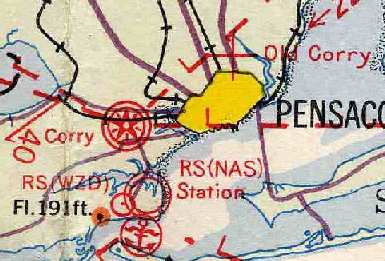
Abandoned & Little-Known Airfields:
Florida, Western Pensacola area
© 2002, © 2016 by Paul Freeman. Revised 4/24/16.
This site covers airfields in all 50 states: Click here for the site's main menu.
____________________________________________________
Please consider a financial contribution to support the continued growth & operation of this site.
Corry Field (1st location) / City Field (revised 4/24/16) - Corry Field NAAS (2nd location) (revised 5/7/13)
____________________________________________________
Corry Field (1st location) / City Field, Pensacola, FL
30.45, -87.22 (Southwest of Pensacola Regional Airport, FL)

The 1934 Navy Aviation Chart V-242 (courtesy of Chris Kennedy) depicted both "Old Corry Field" (along the northern edge of the town)
as well as "New Corry Field" (west of downtown Pensacola).
Corry Field was the first auxiliary field established by the Navy
to support flight training operations at the Pensacola Flight School.
With the announcement in November 1921 that landplane training would soon take place at Pensacola,
Navy planners sought an additional practice field to accommodate increased training activity.
Pensacola city officials offered a 250-acre site north of Pensacola for the new field.
In 1922, the site was obtained from the Escambia County Commission on a no-cost, 5-year lease.
The airfield constructed at this site was named Corry Field in honor of LCDR William M. Corry,
who was posthumously awarded the Medal of Honor for his attempt to rescue a fellow crew member from a burning aircraft.
Training began at Corry Field on 7/1/1922.
The field was sandy & facilities were primitive.
For a time, groundskeepers were on station to keep cows from wandering into the landing area during flight operations,
and a bootlegger had set up a still nearby to supply the aviators with liquid refreshment.
Eventually temporary facilities, including a small barracks, mess hall and garage, were built.
The earliest depiction which has been located of Corry Field
was a 1923 aerial view looking west at a long row of trainers lined up along the northwest edge of a large unpaved airfield,
with a control tower on the northwest side & a hangar on the east side.
Students, after completing their primary seaplane training, began their primary landplane instruction at Corry in the Curtiss JN-4 “Jenny”,
replaced in late 1927 by the Consolidated NY-1.
In 1927, at the end of the original 5-year lease period, the site was deemed too small,
and a new & larger site, located 3 miles north of NAS Pensacola,
was presented to the Navy by the County Commission.
The Corry Field name was applied to this new site (which opened for flight training in 1927),
and the older field became an outlying field (OLF) known as Old Corry Field.
The 1934 Navy Aviation Chart V-242 (courtesy of Chris Kennedy) depicted both "New Corry Field" (west of downtown Pensacola)
as well as an "Old Corry Field" (along the northern edge of the town).
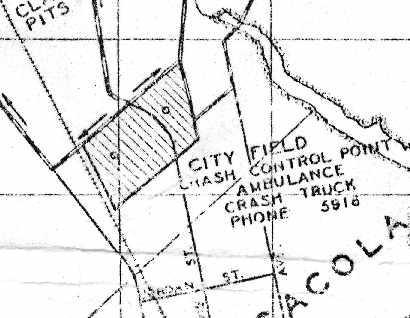
"City Field" was still depicted on a 1939 map of NAS Pensacola & its satellite fields (courtesy of Brian Rehwinkel).
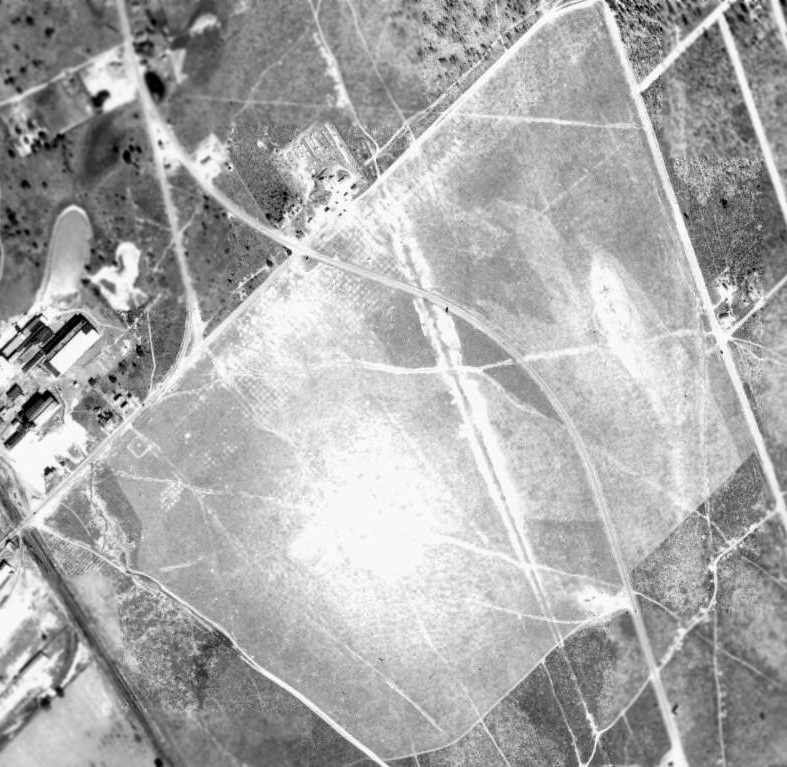
A 12/2/40 USDA aerial view of City Field OLF,
from the Digital Library Center / University of Florida George A. Smathers Libraries (courtesy of Brian Rehwinkel).
"This also shows you how simple the early airfields were for the Navy...
a road (present-day Davis Highway) cuts through the middle of the field.
Apparently the Navy was still using this OLF because there appear to be 2 planes in the eastern portion of the field (near the white circle)."
The outline of Old Corry Field was still labled as a U.S. Naval Reservation on the 1941 USGS topo map.
But Old Corry Field was no longer depicted on the 1945 Mobile Sectional Chart (courtesy of John Voss)
nor listed among active airfields in the 1945 AAF Airfield Directory (courtesy of Scott Murdock).

A 1/4/51 USDA aerial view of the site of the former City Field OLF,
from the Digital Library Center / University of Florida George A. Smathers Libraries (courtesy of Brian Rehwinkel).
"A sub-division has already been built on a portion of the field."
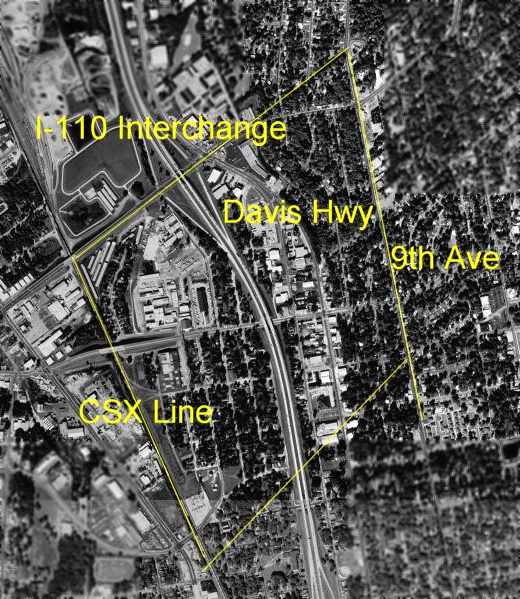
A 1999 USGS aerial photo of the site of City Field,
which has been annotated by Brian Rehwinkel to show present-day landmarks.
Brian Rehwinkel observed, "It may be difficult to see where the airfield used to be,
but there are still landmarks that will help identify the site from the air.
The western edge of the field was the railroad tracks on the left side of the photo.
The northern portion of the field is where the interchange for Interstate 110 is now located (at the top of the photo).
The eastern edge of the field was where today's 9th Avenue is located.
In the photo, 9th Avenue is located just to the right of Davis Highway
(the curved road that went through the middle of the field).
Today, Davis has been divided (north & south) at the point it used to go through City Field.
If you visited this site today,
you would have no idea that this was once the site of one of the earliest (if not the earliest)
auxiliary training fields for the U.S. Navy!"
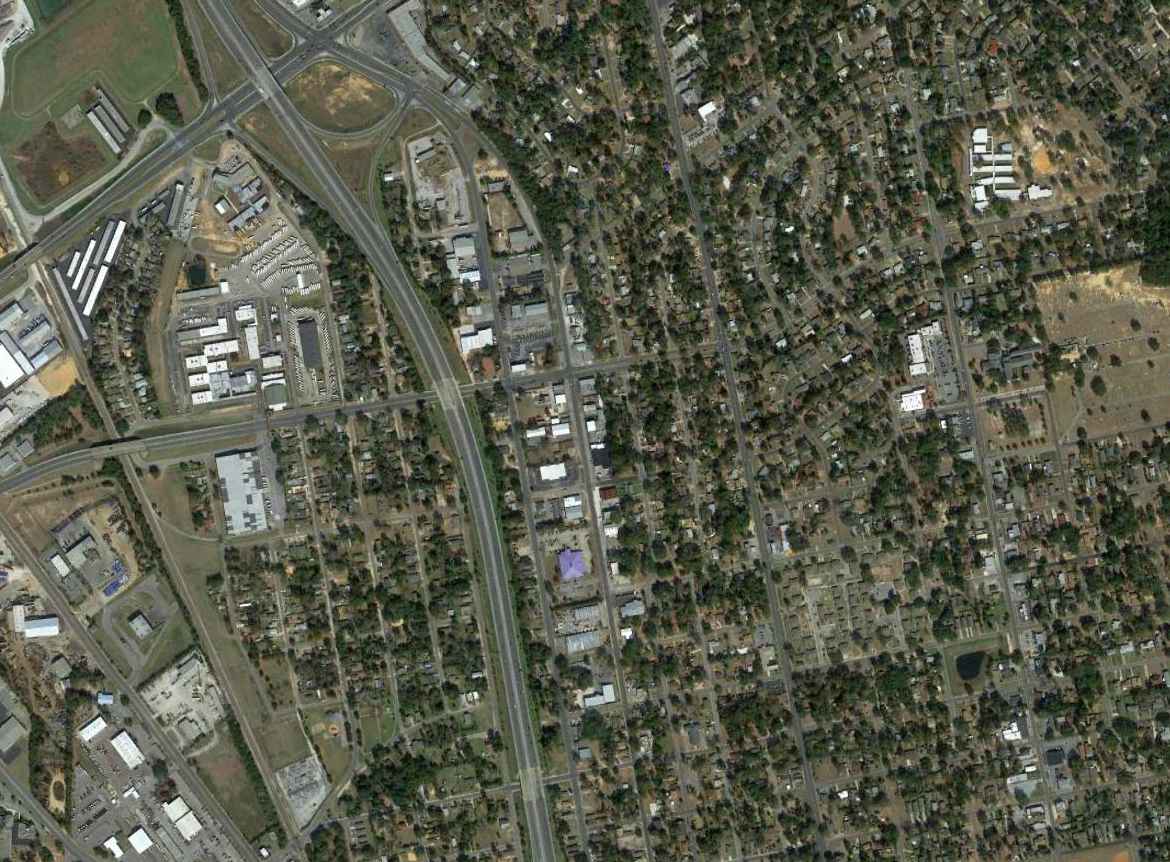
A 2015 aerial photo of the site of City Field.
See also: http://www.pafw.com/corry.htm
____________________________________________________
Corry Field Naval Auxiliary Air Station (2nd location), Myrtle Grove, FL
30.4, -87.29 (West of Pensacola NAS, FL)
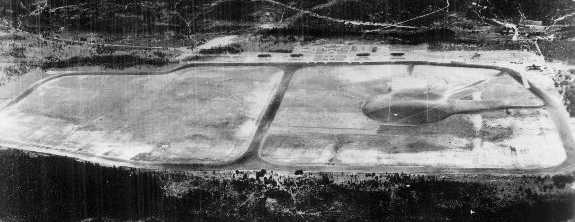
A circa 1920s aerial view looking north at Corry Field.
The "New" Corry Field was built in 1927 on a 500-acre parcel to the west of Pensacola to support flight operations at Pensacola NAS,
to replace the original Corry Field (north of Pensacola),
which had become too small to adequately support Navy flight training operations.
The new Corry Field, though initially unpaved, boasted a galley, three large barracks and a temporary hangar.
A fence at the new field kept the cows from wandering about during flight operations.
With the inauguration of training at the new Corry Field on 7/9/27,
the facility became the home of Training Squadron 2 (primary landplanes) and Training Squadron 5 (fighting planes) for the next 14 years.
Curt Lawson (of NAS Pensacola's Buehler Library) reported about a series of airfield lights used at Corry Field:
“Used between 1927-34 to light the southern edge of the landing field that was only a grass area at the time (i.e. no runways).
The lights had electrical & a gas system for added light augmentation as needed.
The pillars were 15-20' tall & each held a 7' tall light.
Two additional sets of shorter pillars were located along the western & northern field boundaries.
These lights permitted safe clearance of trees & lit the landing areas for the early biplanes (without any onboard lights).
Additional lighting & runway construction was started after 1934 as aircraft & airfield development proceeded.”

An undated (possibly 9/27/30) aerial view looking west at a long row of trainers lined up on Corry Field.
From 1933-36, Corry Field's facilities were significantly upgraded with the construction of permanent brick station buildings & hangars,
whose design became a model for hangars at all future Pensacola auxiliary fields.
As the buildings were constructed, the field was improved as well -
it was paved & taxiways were incorporated into the growing airfield layout as the tail-skid trainers were replaced by those with brakes & tail wheels.

"Corry" Field, as depicted west of Pensacola on the 1934 Navy Aviation Chart V-242 (courtesy of Chris Kennedy).

The location of "New Corry Field", as depicted on the 1934 Navy Aviation Chart V-242 (courtesy of Chris Kennedy).
"New Corry Field" was described as consisting of a 6,243' x 3,970' sandy loam field.

A 10/2/34 U.S. Navy aerial view looking north at Corry Field (courtesy of Brian Rehwinkel).
Brian observed, “This photo shows Corry field after the hangars & other structures were completed.
You can see that by this time the field’s basic layout was complete.
However, the landing areas had not yet been paved… there were paved taxiways around the east & west fields.”

A closeup from the 10/2/34 U.S. Navy aerial view of Corry Field (courtesy of Brian Rehwinkel),
showing the small number of planes present in the picture.
Corry Field was officially dedicated by Rear Admiral Ernest King on December 8, 1934.
A mass formation flight accompanied the dedication ceremonies.

A circa 1934-36 aerial view (from the Emil Beuhler Library at the National Naval Aviation Museum at Pensacola, courtesy of Maureen Keillor)
looking east along an amazing lineup of biplanes at Corry Field.
In the pre-World War II era, Corry consisted of 2 separate fields: East & West.
Students & instructors alike found the traffic pattern to be a nightmare,
a bewildering mixture of primary & fighting planes landing & taking off at the same time.
It was also home to primary elimination glider training in the mid-1930s.
Primary squadrons flew the reliable NY-1 until replaced by the NAF N3N, the Stearman NS and later the N2S beginning in 1935.
VN-5 trained in the Vought VE-7 in the 1920s & the Boeing F3B & F4B series fighters
as well as the Vought O3U & SU & the North American NJ in the 1930s.

A 1938 view of N3Ns, SNJs, and other aircraft on the Corry Field ramp.

A section of a 1939 map of NAS Pensacola & its satellite fields (courtesy of Brian Rehwinkel),
depicting both Corry Field & "Corry Jr", a smaller field adjacent to the south side of Corry Field.
Robert Cooper recalled, “Pre WW2 at Corry Field I flew with many of the instructors in training.”
As the winds of war stirred in 1940, the entire training syllabus was modified to meet expanded training needs.
Corry’s VN-5s fighting aircraft were moved to nearby Saufley Field in August 1940,
to be replaced at Corry by an additional primary training squadron, VN-1B.
Primary training in hundreds of yellow N3Ns & N2Ns was conducted at Corry by VN-1A & VN-1B until late 1942.
The “Yellow Perils” were also used by the Primary Instructor School, based at Corry until early 1943.
The field was designated a Naval Auxiliary Air Station on 15 January 1943.
During WW2, Corry had an outlying field, Pensacola Field #8, at Muscogee, AL.
No trace remains of this outlying field.
In 1942 the NAS Pensacola Transport Unit, flying PBYs, R4Ds and SNBs, found a home at Corry.
The unit was soon redesignated Squadron 8C in January 1943
and conducted multi-engine patrol or VB-2 training in SNBs until moving in November 1943 to Whiting Field.
Joining Squadron 8C in August 1943 was Squadron 6,
conducting carrier aircraft VTB (torpedo/bombing) training initially in land-based OS2Us (and later SNJs) until the end of 1944.
VB-2 training returned to Corry at the end of 1944 & remained there until mid-1947, operating at times more than 160 SNBs.
A utility squadron flying PBYs was also based at Corry for towing targets, patrolling and air-sea rescue.
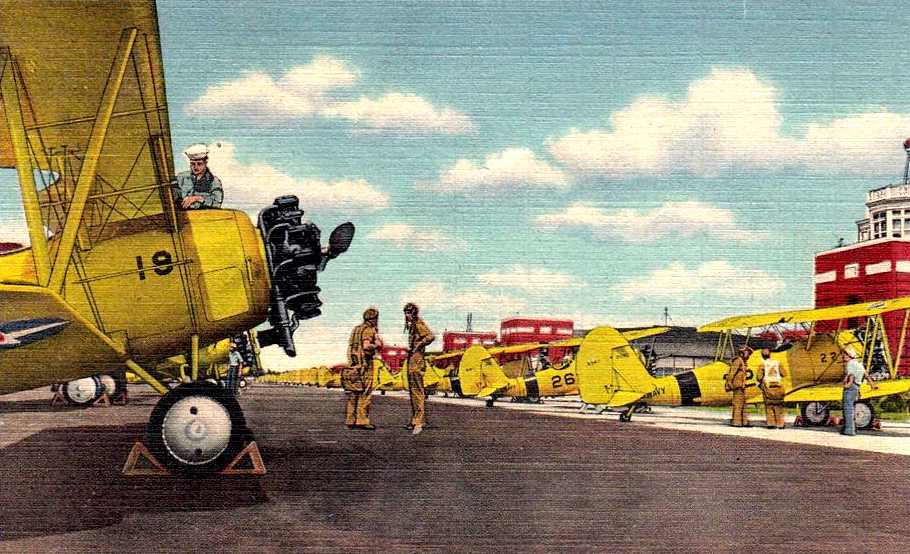
A WW2-era colorized postcard photo of Navy biplane trainers at Corry Field.

The 1944 USGS topo map depicted Corry Field as two open areas, lacking individual runways.
Two labels indicated “Corry Field 1934”, an apparent indication that the depicted configuration was 10 years out of date.
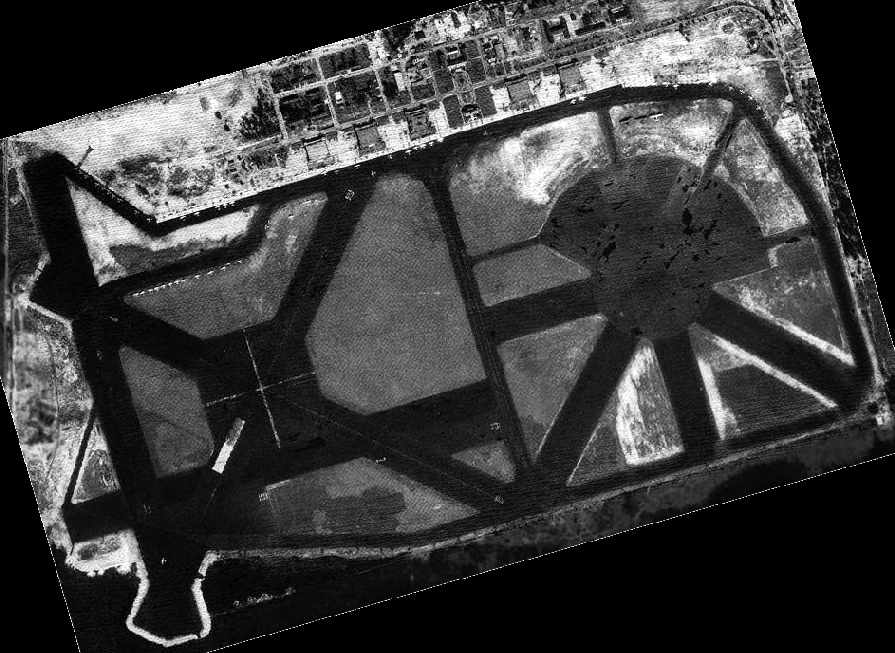
A WW2-era National Archives aerial view of Corry Field.
This small complex had an extremely dense runway layout, with at 8 paved runways in 2 adjacent intersecting groups.
The longest runway was 4,500'.
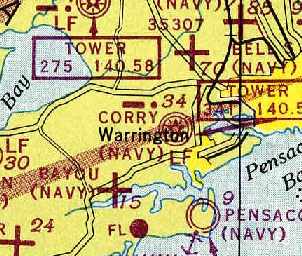
"Corry (Navy)", as depicted on the February 1945 Mobile Sectional Chart (courtesy of Chris Kennedy).
By the end of WW2, Corry Field provided the basic instrument portion of primary flight training.
Corry Field was decommissioned as a NAAS at the end of WW2,
but remained an active training field.
In mid-1947, with the phase-out of the Stearman N2S in the Training Command,
all basic training in SNJs was concentrated in Pensacola when advanced training moved to Corpus Christi.
From mid-1947 until mid-1958, Corry conducted first primary flight training
and then various types of basic flight training that included instruments, night flying and VS/VP basic in SNJs and later T-28s and SNBs.
The field was also home from mid-1949 until mid-1952 to the Basic & Advanced Training Command’s carrier qualification training unit.
Allan Edwards recalled, “I was a USN Tradesman stationed at Corry from early 1954 to 1956 as a Link Trainer Instructor & maintenance man.
I believe it was the NAVBIT 45 Link.”
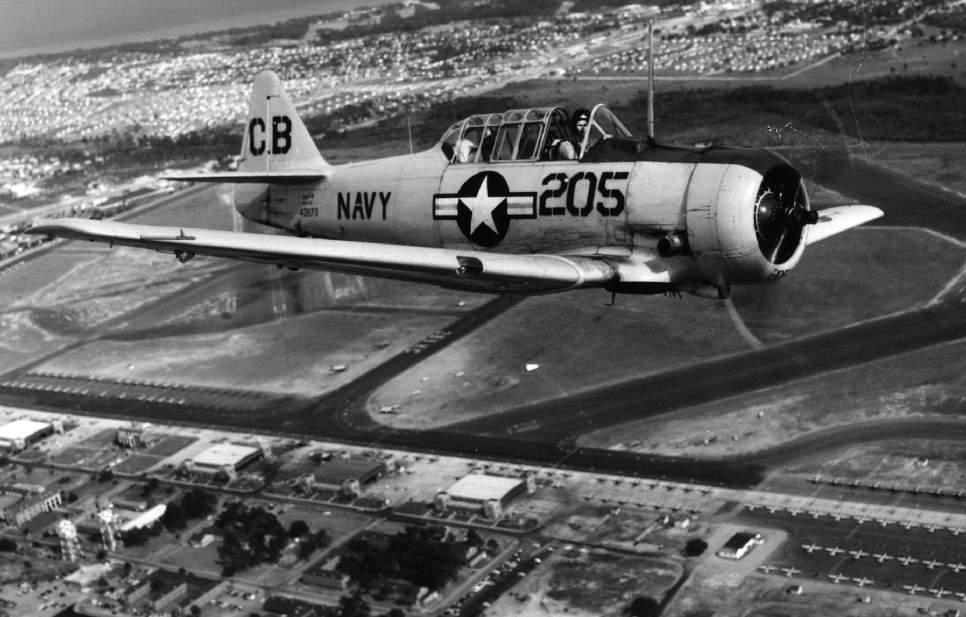
A 1955 USN photo of an SNJ Texan over Corry Field (courtesy of John Voss).

A 1955 USN photo of newly arrived T-28B Trojans at Corry Field, with SNJ Texans behind them (courtesy of John Voss).

An SNJ at Corry in the 1950s, modified into a taxi trainer,
with a temporary nosewheel intended to prevent prop strikes by students (National Archives photo).
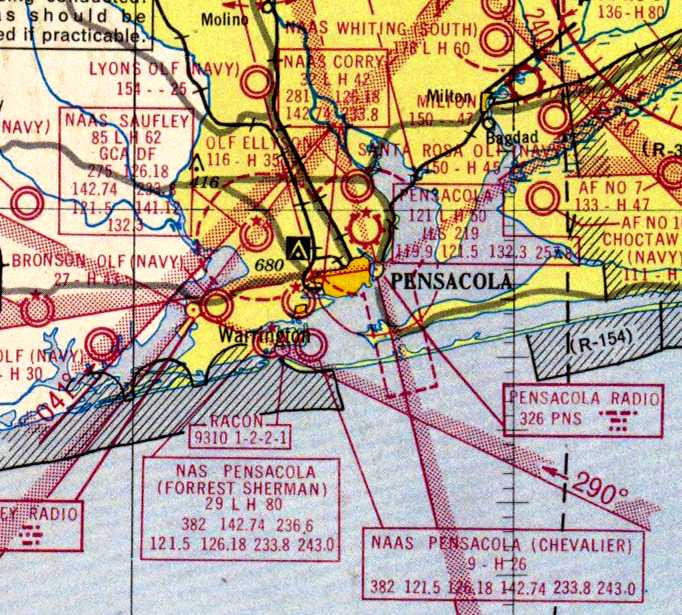
A 1956 aeronautical chart (courtesy of Dallam Oliver-Lee) depicted “NAAS Corry”
(among a dizzying array of Pensacola-area airfields) as having a 4,200' paved runway.
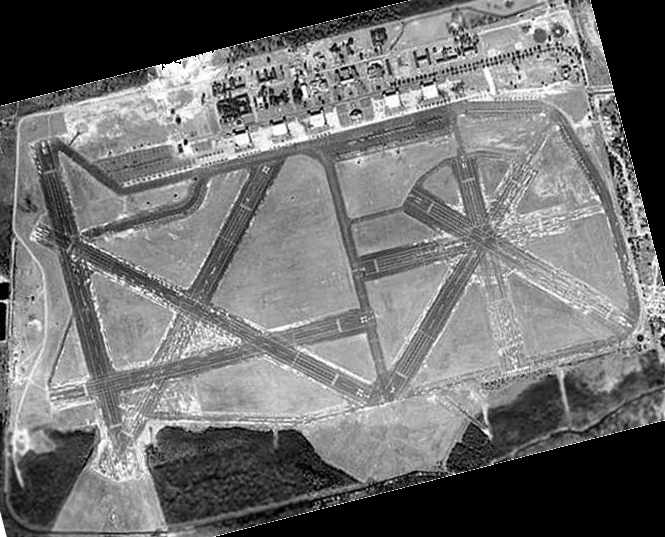
A 1/3/58 USDA aerial view of Corry Field,
from the Digital Library Center / University of Florida George A. Smathers Libraries (courtesy of Brian Rehwinkel).
The photo was taken less than a year before the field ceased flight operations permanently,
but the ramps were still filled with over 100 aircraft.

A close-up of the large number of aircraft on Corry's ramp, from the 1/3/58 USDA aerial view of Corry Field,
from the Digital Library Center / University of Florida George A. Smathers Libraries (courtesy of Brian Rehwinkel).
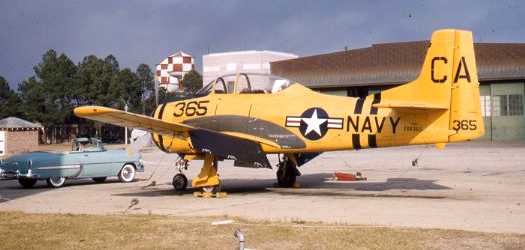
A 1958 photo of a North American T-28B Trojan (& a beautiful 1950s convertible) at Corry Field.
Corry Field was closed in June 1958.
The property remained inactive until 1960,
when the hangars & station buildings were converted to classrooms for the newly arrived Communications Technician school.
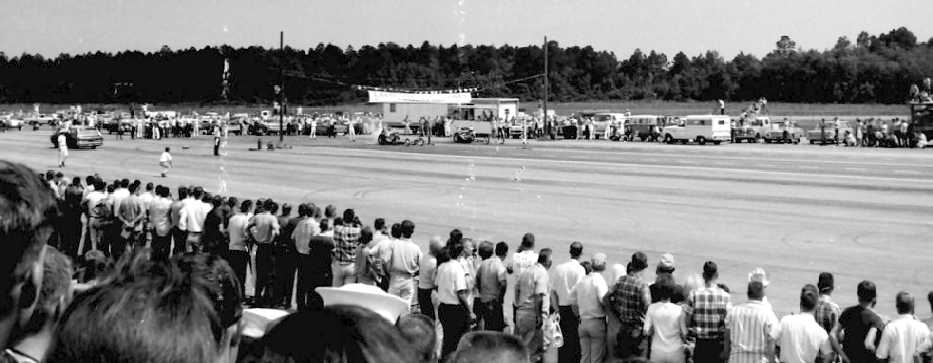
A 1963-64 photo (courtesy of Dallam Oliver-Lee) of a drag race held on a Corry Field runway.
Corry Field was listed as closed on the 1964 Mobile Sectional Chart (courtesy of John Voss).
A 1/27/65 aerial view (courtesy of Dallam Oliver-Lee) showed that a road had been built
across the southwest end of the runways at some point between 1958-65.
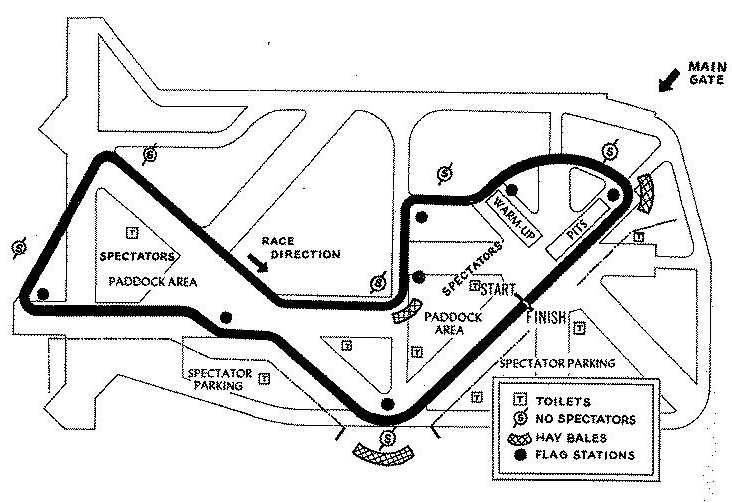
A 1965 map (courtesy of Dallam Oliver-Lee) of an automobile race course laid out on the Corry Field runways.
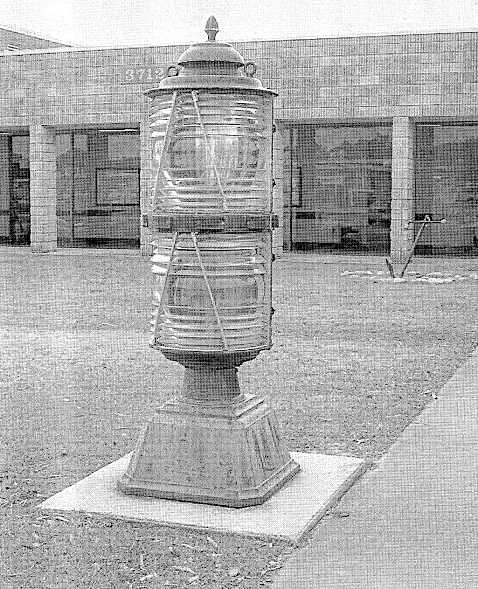
An undated (circa 1960s-70s?) photo (courtesy of Dallam Oliver-Lee) of a “Corry Field Landing Field Floodlight”.
This is the type of light which was mounted on the pillars pictured in the 2013 photo several paragraphs below.
In 1973, the installation's name was changed to Naval Technical Training Center, Corry Station.
Since the change, Corry grew into a highly technical, joint services training center
specializing in cryptology, electronic warfare, advanced calibration, information technology & instructor training.
A 2/10/79 aerial view (courtesy of Dallam Oliver-Lee) showed several buildings had been built
over the western & eastern portions of the airfield at some point between 1965-79.

As seen in the 1999 USGS aerial photo,
the northeastern portion former NAAS is now the site of the Naval Technical Training Center, Corry Station.
The hangars & other buildings are still in use, although in a highly modified form.
The southwest portion of the former airfield has been reused as the site of the Naval Hospital, Pensacola,
while the southeast portion has become the site of the Navy Exchange shopping Mall.
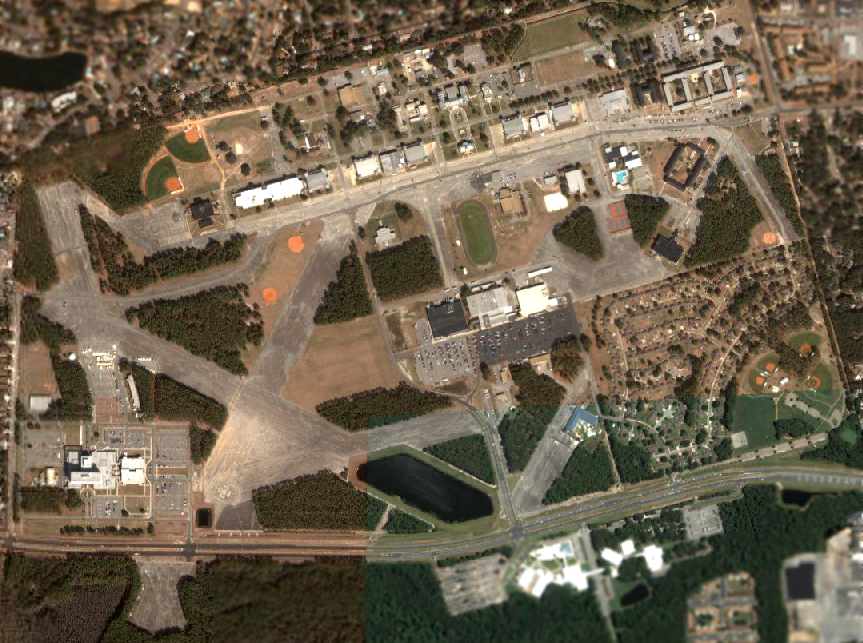
As seen in the 2004 USGS aerial photo, significant portions of at least 8 runways are still intact at the site of the former Corry Field.

A January 2006 photo by Paul Freeman of the sign at the gate for the “Center for Information Dominance, Corry Station”,
which now occupies the northeastern portion of the former airfield.

A January 2006 photo by Paul Freeman looking northeast along a former runway at Corry Field,
which is still used as a helipad for the adjacent Naval Hospital (note the windsock).

A June 2006 photo looking northwest at Corry Field's former operations building & control tower.
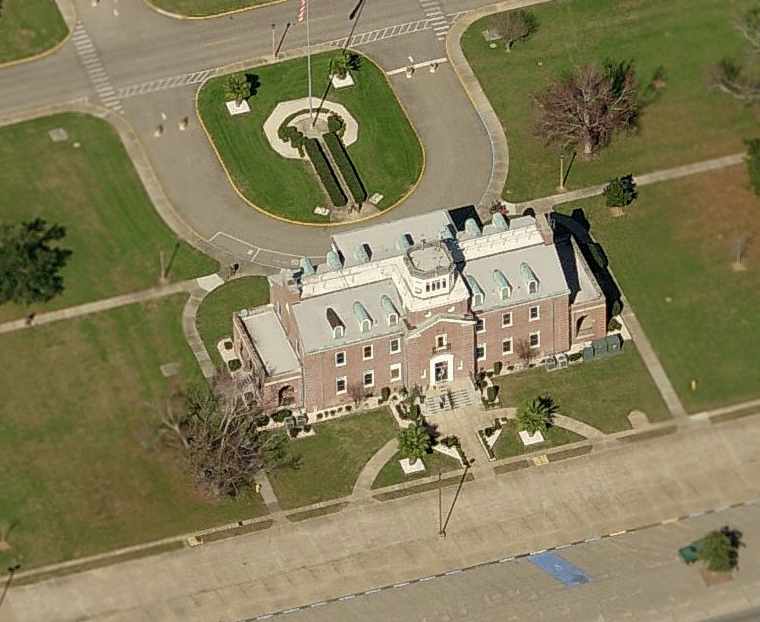
A circa 2006-2007 aerial view looking north at the former operations building & control tower at Corry Field.

A circa 2006-2007 aerial view looking east at 2 of the WW2-era hangars at Corry Field,
with a modern building in between them (which was evidently added at some point between 1958-99).
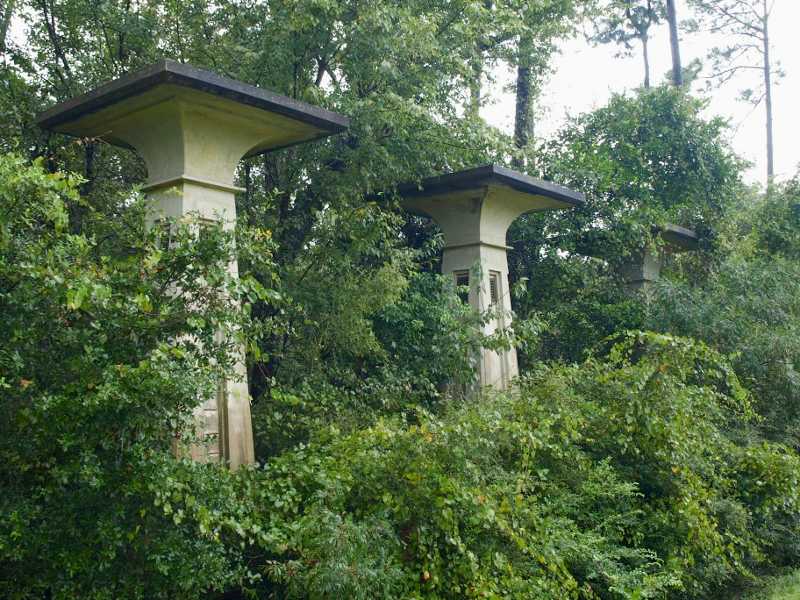
A 2013 photo (courtesy of Dallam Oliver-Lee) of a set of 3 pillars which sit on the south side of the Corry Field property,
south of the intersection of Route 98 & Veteran's Way.
According to Dallam Oliver-Lee, the pillars were visible in a 1965 aerial photo,
and a former Navy pilot indicated the pillars previously mounted airfield lights
(as confirmed by the NAS Pensacola library, several paragraphs above).
See also: http://www.pafw.com/corry.htm
____________________________________________________
Since this site was first put on the web in 1999, its popularity has grown tremendously.
That has caused it to often exceed bandwidth limitations
set by the company which I pay to host it on the web.
If the total quantity of material on this site is to continue to grow,
it will require ever-increasing funding to pay its expenses.
Therefore, I request financial contributions from site visitors,
to help defray the increasing costs of the site
and ensure that it continues to be available & to grow.
What would you pay for a good aviation magazine, or a good aviation book?
Please consider a donation of an equivalent amount, at the least.
This site is not supported by commercial advertising –
it is purely supported by donations.
If you enjoy the site, and would like to make a financial contribution,
you
may use a credit card via
![]() ,
using one of 2 methods:
,
using one of 2 methods:
To make a one-time donation of an amount of your choice:
Or you can sign up for a $10 monthly subscription to help support the site on an ongoing basis:
Or if you prefer to contact me directly concerning a contribution (for a mailing address to send a check),
please contact me at: paulandterryfreeman@gmail.com
If you enjoy this web site, please support it with a financial contribution.
please contact me at: paulandterryfreeman@gmail.com
If you enjoy this web site, please support it with a financial contribution.
____________________________________________________
This site covers airfields in all 50 states.